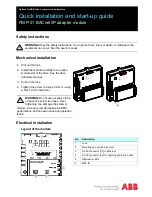
CRADLEPOINT
CBA750B | USER MANUAL Firmware version 5.0
© 2013
CRADLEPOINT, INC. PLEASE VISIT
HTTP://KNOWLEDGEBASE.CRADLEPOINT.COM/
FOR MORE HELP AND RESOURCES
PAGE 98
Enable IPv6 and select the desired IPv6 connection method for this WAN interface.
•
Disabled
(default) – IPv6 disabled on this interface.
•
Auto
– IPv6 will use automatic connection settings (if available).
•
Static
– Input a specific IPv6 address for your WAN connection. This is provided by the ISP if it is supported.
•
6to4 Tunnel
(
http://en.wikipedia.org/wiki/6to4
) – Encapsulates the IPv6 data and transfers it to an automatic tunnel
provider (if your ISP supports it).
•
6in4 Tunnel
(
http://en.wikipedia.org/wiki/6in4
) – Encapsulates the IPv6 data and sends it to the configured tunnel
provider.
•
6rd Tunnel
(IPv6 rapid deployment:
http://en.wikipedia.org/wiki/IPv6_rapid_deployment
) – Encapsulates the IPv6
data and sends it to a relay server provided by your ISP.
When you configure IPv6, you have the option to designate
DNS Servers
and
Delegated Networks
. Because of the
dual-stack setup, these settings are optional: when configured for IPv6, the router will fall back to IPv4 settings when
necessary.
DNS Servers
Each WAN device is required to connect IPv4 before connecting IPv6. Because of this, DNS servers are optional, as most
IPv4 DNS servers will respond with AAAA records (128-bit IPv6 DNS records, most commonly used to map hostnames to
the IPv6 address of the host) if requested. If no IPv6 DNS servers are configured, the system will fall back to the DNS
servers provided by the IPv4 configuration.
Delegated Networks
A delegated network is an IPv6 network that is inherently provided by or closely tied to a WAN IP configuration. The IPv6
model is for each device to have end-to-end IP connectivity without relying on any translation mechanism. In order to
achieve this, each client device on the LAN network needs to have a publicly routable IPv6 address.
Summary of Contents for CBA750B
Page 1: ......
















































